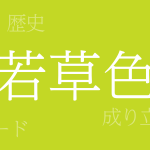Colors are a mirror reflecting culture, allowing us to feel a country’s traditions and history through its hues. Particularly, Japanese traditional colors express the Japanese sensibility that treasures nature’s beauty and the changing seasons. Among these, ‘Chigusa-iro (千草色)’ stands out with its unique allure. This article explores the deep charm of Chigusa-iro.
About Chigusa-iro (千草色)
Chigusa-iro (千草色) is a type of blue-green shade that evokes images of Japan’s natural landscapes. The name ‘Chigusa’ implies a scene abundant with myriad herbs, reminiscent of the color of young grass seen in the fresh green season. While subdued, Chigusa-iro is a fresh and vibrant color brimming with vitality and has been used in various traditional arts such as Kimonos and Japanese paintings.
History of Chigusa-iro
Chigusa-iro has been used since the Heian period, making it a color deeply intertwined with the lives of the Japanese people. Throughout history, it appeared in noble garments and literary works, deeply connected with Japanese aesthetics. It also overlaps with the spirit of nature worship and has been employed in numerous artworks to express the transition of seasons.
Color Codes for Chigusa-iro
When using Chigusa-iro in digital and web design, accurate color codes are essential. Below are the color codes for this hue:
- HEX: #92B5A9
- RGB: R:146 G:181 B:169
- CMYK: C:48 M:21 Y:36 K:0
International Names for Chigusa-iro
Western equivalents for Chigusa-iro include names like “Horizon Blue” and “Teal Green.” However, no Western name can fully capture the unique nuances of Chigusa-iro, so these names should be considered only as approximations.
Summary on Chigusa-iro
Chigusa-iro, as a color symbolizing Japanese tradition and nature, has been cherished for a long time. Understanding its history, significance, and color codes allows for a deeper appreciation and incorporation into various designs. When aiming to integrate a Japanese aesthetic or evoke nature in design, Chigusa-iro is an exceptionally effective choice.

























